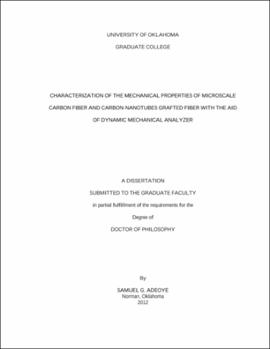| dc.contributor.advisor | SAHA, MRINAL CALTAN, CENGIZ M | |
| dc.creator | ADEOYE, SAMUEL GBADEYAN | |
| dc.date.accessioned | 2019-04-27T21:38:01Z | |
| dc.date.available | 2019-04-27T21:38:01Z | |
| dc.date.issued | 2012 | |
| dc.identifier | 99366989602042 | |
| dc.identifier.uri | https://hdl.handle.net/11244/319208 | |
| dc.description.abstract | Effects of surface modification on tensile and interfacial properties of PAN-based carbon fibers have been investigated. Four different types of commercially available PAN-based carbon fibers namely AS4, AS7, IM10 and T650 were chosen. Both sized and un-sized fibers were investigated. In order to de-size the sized fibers, the fibers were subjected to heat treatment at 435oC in inert atmosphere with 20 minutes and 60 minutes hold time. Moreover, the surface of the fibers was modified using thermal treatment, POSS coating, and carbon nanotubes (CNTs) growth. Thermal treatment was performed inside the chemical vapor deposition (CVD) chamber without the presence of hydrocarbon substance, while CNT growth on the fiber surface was done in the presence of hydrocarbon substance inside the same CVD chamber under controlled temperature and gas environment. Catalyst was distributed on carbon fiber using dip- and spray- methods. The surface morphology was analyzed using high-resolution scanning electron microscope (HR-SEM) and atomic force microscope (AFM), while the mechanical testing was performed using a dynamic mechanical analyzer (DMA). The percent of catalyst particles that were deposited on the fiber were estimated using the thermogravimetric analyzer (TGA). | |
| dc.description.abstract | SEM images showed fewer surface flaws on the carbon fiber with sizing compared to un-sized and de-sized fiber, whereas de-sized fiber showed more surface flaws compared to un-sized fiber which is an indicative of significant thermal degradation of the fiber microstructure. Longer duration of thermal exposure resulted in more surface defects because some parts of the fiber surface layer had been damaged by the heat treatment. The POSS coating seemed to result in less surface defects due to coverage of the carbon fiber with the POSS molecules. It also showed that the catalyst deposition method has a significant effect on the CNT growth rate and their distribution of the carbon fiber during the CVD process. The dip-coating method resulted in more CNT growth than the spray-coating method. This can be attributed to the amount of catalyst particles that were able to be deposited on the respective fiber type as observed using the thermogravimetric analysis. AFM results indicated that the surface roughness is about 64% higher for the sized fiber compared to un-sized fiber. Similar trend is also found true with the de-sized fibers. | |
| dc.description.abstract | Sizing is believed to be chemo-mechanical bonded to fiber surface and thus alleviates the adverse effects of its surface flaws. Consequently, the sizing on the fiber resulted in about 7-12% increase in tensile strength and 8-17% increase in tensile failure strain. Two-parameter Weibull statistical model agrees with this finding as the higher Weibull modulus for the sized fibers is an indicative of the evenly distributed surface flaws. Thermal treatment of the fiber resulted in significant reduction in the tensile strength and failure strain of about 54% and 32%, respectively as a result of thermo-oxidative degradation. Although POSS coating resulted in a small improvement in the tensile strength (about 8%) a significant improvement in the interfacial shear strength (about 39%) was observed. It is believed that POSS molecules act as chemo-mechanical interlock created within the fiber-matrix interface. The poor interfacial performance exhibited by the CNT grafted carbon fiber (about 7% improvement) is possibly due to poor bonding strength of CNT on carbon fiber which possibly caused the CNT to pull-out at the fiber-matrix interface as evidence from the SEM images. It is believed that the CNT-carbon fiber bonding plays important role in the interfacial shear strength of fiber-matrix with CNT growth. The thermally-treated fiber showed about 31% improvement in the interfacial shear strength when compared to as-received un-treated fiber. It is believed that higher surface roughness due to heat treatment provided better anchoring sites on the fiber surface. | |
| dc.format.extent | 195 pages | |
| dc.format.medium | application.pdf | |
| dc.language | en_US | |
| dc.relation.requires | Adobe Acrobat Reader | |
| dc.subject | Carbon fibers | |
| dc.subject | Nanotubes | |
| dc.title | CHARACTERIZATION OF THE MECHANICAL PROPERTIES OF MICROSCALE CARBON FIBER AND CARBON-NANOTUBES GRAFTED FIBER WITH THE AID OF DYNAMIC MECHANICAL ANALYZER | |
| dc.type | text | |
| dc.type | document | |
| dc.thesis.degree | Ph.D. | |
| ou.group | College of Engineering::School of Aerospace and Mechanical Engineering | |
